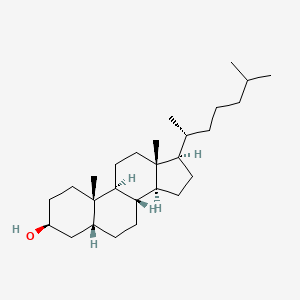| MeSH term | MeSH ID | Detail |
|---|---|---|
| Brain Diseases, Metabolic | D001928 | 9 associated lipids |
| Biliary Fistula | D001658 | 13 associated lipids |
| Xanthomatosis, Cerebrotendinous | D019294 | 14 associated lipids |
| Xanthomatosis | D014973 | 17 associated lipids |
| Alcoholism | D000437 | 27 associated lipids |
| Cataract | D002386 | 34 associated lipids |
| Diabetes Mellitus, Type 2 | D003924 | 87 associated lipids |
| Diabetes Mellitus | D003920 | 90 associated lipids |
| Hypercholesterolemia | D006937 | 91 associated lipids |
Coprosterol
Coprosterol is a lipid of Sterol Lipids (ST) class. Coprosterol is associated with abnormalities such as Cerebrovascular accident, Glycogen Storage Disease Type IV, Coronary Arteriosclerosis, CARDIAC EVENT and Diabetes Mellitus, Non-Insulin-Dependent. The involved functions are known as cholesterol absorption, Death, Sudden, Cardiac, Drug Interactions, Cholesterol Homeostasis and Synthesis. Coprosterol often locates in lipid raft, Tissue membrane, Membrane, Blood and Body tissue. The associated genes with Coprosterol are ABO gene, STN gene, Alleles, Apolipoprotein E gene and TNF gene. The related lipids are saturated fat, campesterol, lathosterol, Sterols and Total cholesterol. The related experimental models are Rodent Model.
Cross Reference
Introduction
To understand associated biological information of Coprosterol, we collected biological information of abnormalities, associated pathways, cellular/molecular locations, biological functions, related genes/proteins, lipids and common seen animal/experimental models with organized paragraphs from literatures.
What diseases are associated with Coprosterol?
Coprosterol is suspected in Coronary Arteriosclerosis, Cerebrovascular accident, Glycogen Storage Disease Type IV, CARDIAC EVENT, Diabetes Mellitus, Non-Insulin-Dependent, Niemann-Pick Diseases and other diseases in descending order of the highest number of associated sentences.
Related references are mostly published in these journals:
| Disease | Cross reference | Weighted score | Related literature |
|---|
Possible diseases from mapped MeSH terms on references
We collected disease MeSH terms mapped to the references associated with Coprosterol
PubChem Associated disorders and diseases
What pathways are associated with Coprosterol
There are no associated biomedical information in the current reference collection.
PubChem Biomolecular Interactions and Pathways
Link to PubChem Biomolecular Interactions and PathwaysWhat cellular locations are associated with Coprosterol?
Visualization in cellular structure
Associated locations are in red color. Not associated locations are in black.
Related references are published most in these journals:
| Location | Cross reference | Weighted score | Related literatures |
|---|
What functions are associated with Coprosterol?
Related references are published most in these journals:
| Function | Cross reference | Weighted score | Related literatures |
|---|
What lipids are associated with Coprosterol?
Related references are published most in these journals:
| Lipid concept | Cross reference | Weighted score | Related literatures |
|---|
What genes are associated with Coprosterol?
Related references are published most in these journals:
| Gene | Cross reference | Weighted score | Related literatures |
|---|
What common seen animal models are associated with Coprosterol?
Rodent Model
Rodent Model are used in the study 'Formation of 7-dehydrocholesterol-containing membrane rafts in vitro and in vivo, with relevance to the Smith-Lemli-Opitz syndrome.' (Keller RK et al., 2004).
Related references are published most in these journals:
| Model | Cross reference | Weighted score | Related literatures |
|---|
NCBI Entrez Crosslinks
All references with Coprosterol
Download all related citations| Authors | Title | Published | Journal | PubMed Link |
|---|---|---|---|---|
| Cabral AC et al. | An integrated evaluation of some faecal indicator bacteria (FIB) and chemical markers as potential tools for monitoring sewage contamination in subtropical estuaries. | 2018 | Environ. Pollut. | pmid:29339343 |
| Othman RA et al. | Thyroid Hormone Status in Sitosterolemia Is Modified by Ezetimibe. | 2017 | J. Pediatr. | pmid:28625503 |
| Alhariri A et al. | Clinical report: A patient with a late diagnosis of cerebrotendinous xanthomatosis and a response to treatment. | 2017 | Am. J. Med. Genet. A | pmid:28590052 |
| Mast N et al. | Cytochrome P450 27A1 Deficiency and Regional Differences in Brain Sterol Metabolism Cause Preferential Cholestanol Accumulation in the Cerebellum. | 2017 | J. Biol. Chem. | pmid:28190002 |
| Tibrewal S et al. | Cerebrotendinous xanthomatosis: early diagnosis on the basis of juvenile cataracts. | 2017 | J AAPOS | pmid:29079218 |
| Chen C et al. | Clinical and molecular genetic features of cerebrotendinous xanthomatosis patients in Chinese families. | 2017 | Metab Brain Dis | pmid:28623566 |
| Reis SA et al. | Mechanisms responsible for the hypocholesterolaemic effect of regular consumption of probiotics. | 2017 | Nutr Res Rev | pmid:27995830 |
| Koyama S and Kato T | Pathophysiology of cerebrotendinous xanthomatosis. | 2016 | Rinsho Shinkeigaku | pmid:27840382 |
| Koge J et al. | A case of cerebrotendinous xanthomatosis mimicking the clinical phenotype of mitochondrial disease with a novel frame-shift mutation (c. 43_44 delGG) in CYP27A1 gene exon 1. | 2016 | Rinsho Shinkeigaku | pmid:27680221 |
| Mattis CE and Mootoo DR | A ring closing metathesis strategy for carbapyranosides of xylose and arabinose. | 2016 | Carbohydr. Res. | pmid:27236269 |
